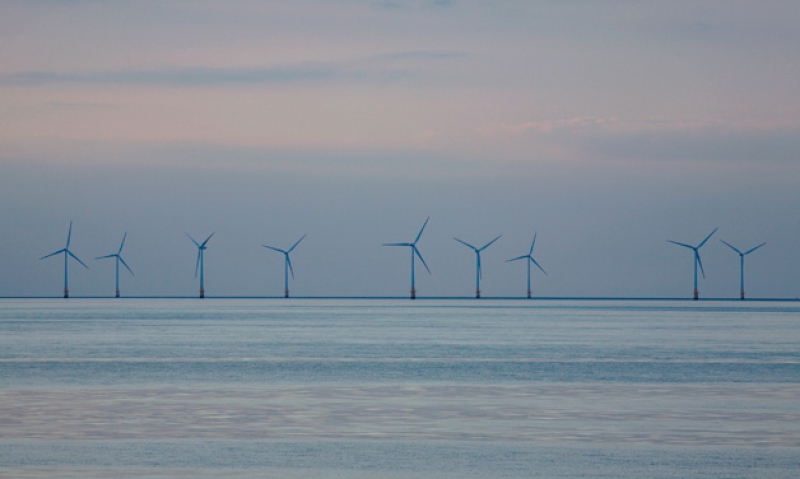
Veterans groups on both sides of the Atlantic are voicing opposition to the French president's plan to build wind turbines off the Normandy coast.
Veterans groups on both sides of the Atlantic are voicing opposition to French President Nicolas Sarkozy’s plan to allow energy firms to build up to 100 wind turbines off the Normandy coast. If Sarkozy’s plans go forward, massive turbines – up to 525 feet high – will be planted seven miles off what was known as "Juno Beach" on D-Day. This is a bad idea for at least two reasons.
First and foremost, there’s the historical importance of the waters that lap onto Normandy – waters that delivered the largest amphibious-landing force in history, waters that turned red with the blood of heroes on June 6, 1944.
Claiming that the project will power 4.5 million homes, French government officials promise that the giant windmills will be so far out to sea that they will be like "matchsticks" to those gazing out from the beaches.
World War II veterans and historical societies aren’t buying that defense.
"They will be visible from all the Normandy landing beaches: Utah, Omaha, Gold, Juno and Sword," Gérard Lecornu, president of the Port Winston Churchill Association of Arromanches, told Britain’s Telegraph newspaper. "D-Day is in our collective memory. To touch this is a very grave attack on that memory."
How grave? In Britain, some veteran RAF pilots have warned – perhaps tongue-in-cheek, perhaps not – that they might take to the air again to bomb the windmills.
Tim Holbert, executive director of the American Veterans Center, wants the French to rethink the placement of the wind turbines. "Thousands died there," he told Fox News. "It’s considered sacred ground for a lot of people."
Given that Juno was Canada’s beachhead on D-Day, Sarkozy’s plans are especially unsettling to Canadian veterans. Calling the Normandy beaches "hallowed grounds," D-Day veteran Jack Martin described the wind-farm plans as "a disgusting affair" in an interview with Canada’s CTV network.
That sort of reaction has led some to launch a petition drive with the aim of asking the U.N. to designate the beaches as a historically protected area.
According to Rudyard Griffiths, co-founder of a Toronto-based historical group, "To be able to walk those beaches, and see them and imagine them as if it was 1944 is, in some ways, essential to keeping that historical memory alive."
There’s something to that. Would we want a solar-panel field filling the World Trade Center’s footprint, a wind turbine on top of the USS Arizona Memorial, or an oil derrick sprouting up from Gettysburg’s Little Round Top?
In fact, in an interview with The Daily Caller’s Caroline May, military historian Paul Stillwell noted that something not too dissimilar happened in Gettysburg. "Some years ago," he explained, "an entrepreneur put up a large observation tower [on the Gettysburg battleground], which was considered a desecration, and public opinion was such that it was finally demolished."
The planned Normandy-area wind farm is just one part of a massive effort to plant 1,200 turbines along the French coastline by 2020. The French government believes that the $28.6 billion wind-farm project will create 10,000 jobs and generate the electricity equivalent of two nuclear power plants, according to the Telegraph. Best of all, say the project’s proponents, it’s all clean and green.
That brings us to a second problem with Sarkozy’s wind-farm plans: Modern-day windmills may not produce greenhouse gases, but they are anything but environmentally friendly.
As Robert Bryce, editor of the Energy Tribune, reports, wind turbines in the United States kill between 75,000 and 275,000 birds annually. He points out that a county agency in California concluded that a wind farm in California’s Altamont Pass kills 10,000 birds – "nearly all protected by the Migratory Bird Act" – per year.
Writing in Canada’s Financial Post, Diane Katz notes that "Such numbers earned wind-power generators the moniker ‘Cuisinarts of the Air,’ but not indictments." She adds that in Canada "the wind-power industry enjoys a degree of political favor that would make most other energy executives green with envy. The province of Ontario, for example, actually requires utilities to purchase wind power at inflated rates."
The double standards aren’t confined north of the border. Bryce notes that ExxonMobil was hauled before a federal court and had to pay a fine of $600,000 when the oil giant pled guilty to killing 85 birds that had inadvertently been exposed to hazardous areas on its property. PacifiCorp, an electric utility, was ordered to pay $1.4 million for killing 232 eagles.
"Yet there is one group of energy producers that are not being prosecuted for killing birds: wind-power companies," Bryce writes. "And wind-powered turbines are killing a vast number of birds every year."
To be sure, finding alternative sources of energy is important for Europeans and Americans alike, and U.S. law has nothing to do with how France generates electricity. But if Sarkozy wants to power France with clean, green, bird-killing windmills, he should find someplace else to do it. Given what Americans did for France at Normandy, we’ve earned the right to tell him that.
- Landing Zone

